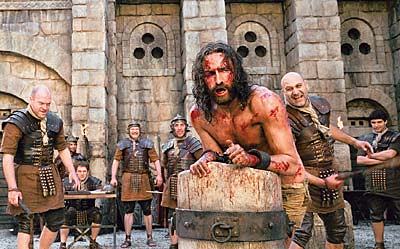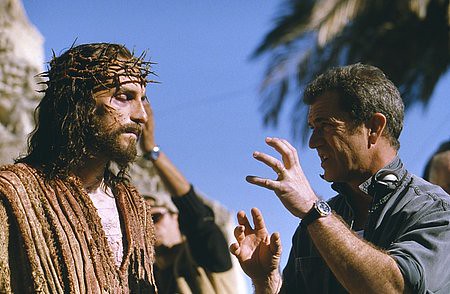It Is As It Was?
THE PASSION OF THE CHRIST
directed by Mel Gibson
 Evocative.
Evocative.
There has already been so much said regarding the production of Mel Gibson’s film, the subsequent controversy it has evoked, and the cross-denominational support it has engendered. One could talk endlessly about any one of these subjects. However, the flurry of emotions preceding and running rampant around the periphery of this film failed to capture or prepare the viewer for the undeniable power of the cinema experience itself.
The only thing certain to overshadow this two-hour, nine-minute experience will be the inevitably strong reaction of every single viewer carried out of the theatre and into their communities well after the credits have rolled.
I saw the film with my wife, a few Christian friends, and a gaggle of theatre employees. Some of the latter made snickering remarks before the film began, teasing about weak people who would cry and be overly-sentimental about the movie’s content. They seemed to have little interest in the film. We were not subjected to any trailers or commercials (apparently a decision made for ALL Regal Cinemas), merely a black screen and then the Icon Pictures Logo introducing the film. (What preview would one advertise before the death of Christ, I wonder? The latest Adam Sandler flick? Spider-Man 2? Without knowing for certain, Regal’s decision strikes of understanding and respect). The film opened with a familiar quote from Isaiah, a prophecy written down 700 years before Christ. We then cut to the Garden of Gethsemane and, over the course of two hours, follow the Son of God from the garden to the grave.
I am not, like some Christians, going to suggest that this film offered the most profound understanding of Christ’s sacrifice I have ever experienced. This would denigrate the powerful moment of my conversion many years ago, and to a much lesser degree insult the power of my own imagination when I read and visualize the scriptures. However, like a skilled preacher, Gibson’s cinematic, narrative sermon is a powerful paraphrase, and it cut like a knife into everyone seated in that theatre. Silence pervaded over the small audience, and the employees left in a somber silence, unwilling or unable to talk about what they had witnessed. Conviction, perhaps? Guilt, or mere confusion? What they experienced I can only speculate, but the impression was certainly indelible.
 The performances in the film are lush and nuanced, from Caviezel’s honoring portrayal of Christ to the conflicted Pilate and condemned Judas. Though I’m admittedly not fluent in Aramaic or Latin, to the untrained eye the actors appeared comfortable and at home with the languages, their emotions gushing through with earnest fervor. Additionally, one of the most subtle yet disturbing performances is manifest in the androgynous form of Satan (played with a chilling evil grace by Rosalinda Celentano). As the fallen angel lurks in the corners and behind the crowds, reveling in or inciting the moment, there is something sinister that makes the viewer’s hair stand on end.
The performances in the film are lush and nuanced, from Caviezel’s honoring portrayal of Christ to the conflicted Pilate and condemned Judas. Though I’m admittedly not fluent in Aramaic or Latin, to the untrained eye the actors appeared comfortable and at home with the languages, their emotions gushing through with earnest fervor. Additionally, one of the most subtle yet disturbing performances is manifest in the androgynous form of Satan (played with a chilling evil grace by Rosalinda Celentano). As the fallen angel lurks in the corners and behind the crowds, reveling in or inciting the moment, there is something sinister that makes the viewer’s hair stand on end.
The film, though on a modest budget, is beautifully shot by Caleb Deschanel and bears few signs of financial limitations. Many will talk about the film as a “useful tool” for spreading the truth of Christ, but (while I fully concur) it also must be impressed that the film is truly a labor of love and artistic achievement, which is part and parcel of why it WILL be such a useful tool. There is a particular scene which induced the most tears; Mary, played by the Romanian actress Maia Morgenstern, holds her dead son in her arms as he is brought down from the cross. Holding her son in a state of shock, she looks up soulfully at the horizon, which, because the camera is facing her, means she’s looking out at the viewing audience. There is a heavy indictment here, as the film has clearly articulated that Jesus has just died for the sins of the world (indeed, the sins of the viewers), and Morgenstern’s watery eyes deftly articulate the depths of a mother’s loss. A thoughtful viewer, truly immersed in the moment, will shrivel into their seat as they realize that, while they’d sincerely wish reach out and comfort this wounded woman, her son’s blood is on their hands and any excuse is rendered moot. While the film could have painted-by-numbers and pleased most Christians, (who are too often satisfied by the merely perfunctory), the tender care with which the art direction and acting are handled in “The Passion of Christ” produces a result which affects Christian and non-Christian alike, whether they fully understand it or not.
I would do the reader a disservice by avoiding the topic of violence and blood in the film. It IS truly brutal to watch and, while not glorying in its gore like so many horror or war movies, one might say it is even MORE brutal than these because it strikes a convicting chord. My wife had to look away repeatedly and, though I did not, each strike of whip or brutal beating hurt emotionally as the phrase “because of my sin” echoed repeatedly in my head. My non-Christian friend (the theatre manager) asked us afterward, “as Christians”, what he might expect from other Christians attending the film when it opens February 25th. Without a full understanding of Christianity, his concern was that Christians might be angry or offended by the “violent content”. My wife, bless her heart, responded without missing a beat. She told him that it did indeed offend her. and that it had every right to offend her, as it ought to offend everyone (Christian or non-Christian), bombarded with the extremely visceral truth of what Christ endured on our behalf.
Not five minutes had passed since the film had ended, and I witnessed two people very passionately expressing the gospel to non-believers. In my mind, that alone made this entire cinematic effort worthwhile. Gibson is careful in his film to articulate throughout Christ’s trial, crucifixion, and various flashbacks to his life and ministry that he claimed to be the Way, the Truth, and the Life, and that no one comes to God except through Him. Mel makes certain to show that Christ did not stay in the grave, but rather that He embodied everything he claimed about Himself. Certainly some viewers and critics will try to paint over this, appreciating the film for its “artistry” and trying to separate themselves from the message implicit within the art. However, I anticipate the vast majority of viewers will have more honest, severe reactions to the film: anger, tears, denial, disgust, submission, revulsion, and for some. transformation.



What other Jesus movies do you recommend?